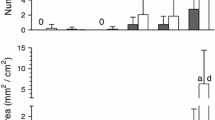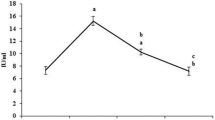Abstract
To determine the threshold dose of piperonyl butoxide (PBO) that induces hepatocellular tumor-promoting effects, reactive oxygen species (ROS) generation, and drug-metabolizing enzymes that protect against ROS generation, partial hepatectomized rats were fed diets containing 0, 0.015, 0.03, 0.06, 0.125, 0.25, or 0.5% PBO after an i.p. injection of N-diethylnitrosamine (DEN) to initiate hepatocarcinogenesis. Histopathologically, Glutathione S-transferase placental form (GST-P)-positive foci were significantly increased in a dose-dependent manner in rats given 0.25% PBO or higher. The formation of microsomal ROS in the liver was significantly increased in 0.25 and 0.5% PBO. Real-time RT-PCR showed that the expression of the CYP1A1, UDPGTr-2, and Mrp3 genes was significantly upregulated in rats given 0.03% PBO or higher. These results suggest that 0.25% is the threshold dose of PBO that induces ROS-mediated hepatocarcinogenesis in rats, although the CYP1A1 gene that is related to ROS generation and the UDPGTr-2 and Mrp3 genes that are involved in protection against ROS were induced in the livers of rats even at a PBO dose of 0.03%.






Similar content being viewed by others
Abbreviations
- ABC:
-
Streptavidin–biotin peroxidase complex
- Akr7a3:
-
Aflatoxin B1-aldehyde reductase
- BSA:
-
Bovie serum albumin
- CYP1A1:
-
Cytochrome P4501A1
- DAB:
-
3, 3′-Diaminobenzidine
- DCFH-DA:
-
2′,7′-Dichlorodihydrofluorescein diacetate
- DCF:
-
2′,7′-Dichlorofluorescein
- DEN:
-
N-Diethylnitrosamine
- GPX-2:
-
Glutathione peroxidase 2
- GRx:
-
Glutaredoxin
- GST-P:
-
Glutathione S-transferase placental form
- H&E:
-
Hematoxylin and eosin
- HPLC:
-
High performance liquid chromatography
- i.p.:
-
Intraperitoneal
- Nqo1:
-
NAD(P):quinine oxidoreductase
- Mrp3:
-
Multidrug resistance protein3
- PBO:
-
α-[2-(2-Butoxyethoxy)ethoxy]-4, 5-methylenedioxy-2-propyltoluene
- PBS:
-
Phosphate-buffered saline
- ROS:
-
Reactive oxygen species
- UDPGTr-2:
-
UDP-glucronosyltransferase
- RT-PCR:
-
Reverse transcriptase polymerase chain reaction
- 8-OHdG:
-
8-Hydroxydeoxyguanosine
- Slc7a5:
-
Solute carrier family 7 (cationic amino acid transporter, y+ system), member 5
- TCDD:
-
2,3,7,8-Tetrachlorodibenzo-p-dioxin
- PCNA:
-
Proliferating cell nuclear antigen
- EDTA-2Na:
-
Ethylene diamine tetraacetic acid disodium
- DTT:
-
Dithiothreitol
- PMSF:
-
Phenylmethylsulfonyl fluoride
References
Asare GA, Mossanda KS, Kew MC et al (2006) Hepatocellular carcinoma caused by iron overload: a possible mechanism of direct hepatocarcinogenicity. Toxicology 219:41–52
Beamand JA, Price RJ, Phillips JC et al (1996) Lack of effect of piperonyl butoxide on unscheduled DNA synthesis in precision-cut human liver slices. Mutat Res 371:273–282
Cherrington NJ, Hartley DP, Li N et al (2002) Organ distribution of multidrug resistance proteins 1, 2, and 3 (Mrp1, 2, and 3) mRNA and hepatic induction of Mrp3 by constitutive androstane receptor activators in rats. J Pharmacol Exp Ther 300:97–104
Chesis PL, Levin DE, Smith MT et al (1984) Mutagenicity of quinones: pathways of metabolic activation and detoxification. Proc Natl Acad Sci USA 81:1696–1700
Chu FF, Esworthy RS, Doroshow JH (2004) Role of Se-dependent glutathione peroxidases in gastrointestinal inflammation and cancer. Free Radic Biol Med 36:1481–1495
Fujitani T, Ando H, Fujitani K et al (1992) Sub-acute toxicity of piperonyl butoxide in F344 rats. Toxicology 72:291–298
Fujitani T, Tanaka T, Hashimoto Y et al (1993) Subacute toxicity of piperonyl butoxide in ICR mice. Toxicology 83:93–100
Goldstein JA, Hickman P, Kimbrough RD (1973) Effects of purified and technical piperonyl butoxide on drug-metabolizing enzymes and ultrastructure of rat liver. Toxicol Appl Pharmacol 26:444–458
Gouaze V, Mirault ME, Carpentier S et al (2001) Glutathione peroxidase-1 overexpression prevents ceramide production and partially inhibits apoptosis in doxorubicin-treated human breast carcinoma cells. Mol Pharmacol 60:488–496
Guengerich FP, Shimada T (1991) Oxidation of toxic and carcinogenic chemicals by human cytochrome P-450 enzymes. Chem Res Toxicol 4:391–407
Hayes JD, Judah DJ, Neal GE (1993) Resistance to aflatoxin B1 is associated with the expression of a novel aldo-keto reductase which has catalytic activity towards a cytotoxic aldehyde-containing metabolite of the toxin. Cancer Res 53:3887–3894
Hockenbery DM, Oltvai ZN, Yin XM et al (1993) Bcl-2 functions in an antioxidant pathway to prevent apoptosis. Cell 75:241–251
Judah DJ, Hayes JD, Yang JC et al (1993) A novel aldehyde reductase with activity towards a metabolite of aflatoxin B1 is expressed in rat liver during carcinogenesis and following the administration of an anti-oxidant. Biochem J 292:13–18
Keum YS, Owuor ED, Kim BR et al (2003) Involvement of Nrf2 and JNK1 in the activation of antioxidant responsive element (ARE) by chemopreventive agent phenethyl isothiocyanate (PEITC). Pharm Res 20:1351–1356
Konig J, Nies AT, Cui Y et al (1999) Conjugate export pumps of the multidrug resistance protein (MRP) family: localization, substrate specificity, and MRP2-mediated drug resistance. Biochim Biophys Acta 1461:377–394
LeBel CP, Ali SF, McKee M et al (1990) Organometal-induced increases in oxygen reactive species: the potential of 2′,7′-dichlorofluorescin diacetate as an index of neurotoxic damage. Toxicol Appl Pharmacol 104:17–24
Lin PH, Lin CH, Huang CC et al (2007) 2,3,7,8-Tetrachlorodibenzo-p-dioxin (TCDD) induces oxidative stress, DNA strand breaks, and poly(ADP-ribose) polymerase-1 activation in human breast carcinoma cell lines. Toxicol Lett 172:146–158
Livak KJ, Schmittgen TD (2001) Analysis of relative gene expression data using real-time quantitative PCR and the 2(-Delta Delta C(T)). Method 25:402–408
Long DJ 2nd, Waikel RL, Wang XJ et al (2001) NAD(P)H:quinone oxidoreductase 1 deficiency and increased susceptibility to 7,12-dimethylbenz[a]-anthracene-induced carcinogenesis in mouse skin. J Natl Cancer Inst 93:1166–1170
Mackenzie PI, Rodbourn L (1990) Organization of the rat UDP-glucuronosyltransferase, UDPGTr-2, gene and characterization of its promoter. J Biol Chem 265:11328–11332
Moriya K, Nakagawa K, Santa T et al (2001) Oxidative stress in the absence of inflammation in a mouse model for hepatitis C virus-associated hepatocarcinogenesis. Cancer Res 61:4365–4370
Muguruma M, Nishimura J, Jin M et al (2006) Molecular pathological analysis for determining the possible mechanism of piperonyl butoxide-induced hepatocarcinogenesis in mice. Toxicology 228:178–187
Muguruma M, Unami A, Kanki M et al (2007) Possible involvement of oxidative stress in piperonyl butoxide induced hepatocarcinogenesis in rats. Toxicology 236:61–75
Nie AY, McMillian M, Parker JB et al (2006) Predictive toxicogenomics approaches reveal underlying molecular mechanisms of nongenotoxic carcinogenicity. Mol Carcinog 45:914–933
Nishikawa T, Wanibuchi H, Ogawa M et al (2002) Promoting effects of monomethylarsonic acid, dimethylarsinic acid and trimethylarsine oxide on induction of rat liver preneoplastic glutathione S-transferase placental form positive foci: a possible reactive oxygen species mechanism. Int J Cancer 100:136–139
Okamiya H, Mitsumori K, Onodera H et al (1998) Mechanistic study on liver tumor promoting effects of piperonyl butoxide in rats. Arch Toxicol 72:744–750
Ogawa K, Suzuki H, Hirohashi T et al (2000) Characterization of inducible nature of MRP3 in rat liver. Am J Physiol Gastrointest Liver Physiol 278:G438–G446
Puntarulo S, Cederbaum AI (1998) Production of reactive oxygen species by microsomes enriched in specific human cytochrome P450 enzymes. Free Radic Biol Med 24:1324–1330
Rocher B, Le Goff J, Peluhet L et al (2006) Genotoxicant accumulation and cellular defence activation in bivalves chronically exposed to waterborne contaminants from the Seine River. Aquat Toxicol 79:65–77
Roelofsen H, Muller M, Jansen PL (1997) Regulation of organic anion transport in the liver. Yale J Biol Med 70:435–445
Serron SC, Dwivedi N, Backes WL (2000) Ethylbenzene induces microsomal oxygen free radical generation: antibody-directed characterization of the responsible cytochrome P450 enzymes. Toxicol Appl Pharmacol 164:305–311
Szejda P, Parce JW, Seeds MS et al (1984) Flow cytometric quantitation of oxidative product formation by polymorphonuclear leukocytes during phagocytosis. J Immunol 133:3303–3307
Takahashi O, Oishi S, Fujitani T et al (1994) Piperonyl butoxide induces hepatocellular carcinoma in male CD-1 mice. Arch Toxicol 68:467–469
Tian X, Zamek-Gliszczynski MJ, Zhang P et al (2004) Modulation of multidrug resistance-associated protein 2 (Mrp2) and Mrp3 expression and function with small interfering RNA in sandwich-cultured rat hepatocytes. Mol Pharmacol 66:1004–1010
Trush MA, Kensler TW (1991) An overview of the relationship between oxidative stress and chemical carcinogenesis. Free Radic Biol Med 10:201–209
Wagner M, Halilbasic E, Marschall HU et al (2005) CAR and PXR agonists stimulate hepatic bile acid and bilirubin detoxification and elimination pathways in mice. Hepatology 42:420–430
Watanabe M, Kikuchi H, Sagami I et al (1998) Role of cytochrome p-450 in chemical toxicity and carcinogenesis. J Toxicol Pathol 2:241–251
Wiseman H, Halliwell B (1996) Damage to DNA by reactive oxygen and nitrogen species: role in inflammatory disease and progression to cancer. Biochem J 313:17–29
Yang LY, Chen WL, Lin JW et al (2005) Differential expression of antioxidant enzymes in various hepatocellular carcinoma cell lines. J Cell Biochem 96:622–631
Yeh CT, Yen GC (2006) Induction of hepatic antioxidant enzymes by phenolic acids in rats is accompanied by increased levels of multidrug resistance-associated protein 3 mRNA expression. J Nutr 136:11–15
Acknowledgments
This research was supported by a part of Grant-in-Aid 564 for the Research Program for Risk Assessment Study on 565 Food Safety from the Food Safety Commission, Japan 0501.
Author information
Authors and Affiliations
Corresponding author
Rights and permissions
About this article
Cite this article
Muguruma, M., Kawai, M., Dewa, Y. et al. Threshold dose of piperonyl butoxide that induces reactive oxygen species-mediated hepatocarcinogenesis in rats. Arch Toxicol 83, 183–193 (2009). https://doi.org/10.1007/s00204-008-0340-8
Received:
Accepted:
Published:
Issue Date:
DOI: https://doi.org/10.1007/s00204-008-0340-8




